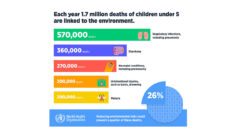Jabukie Young-White presents a comical case on The Daily Show with Trevor Noah, arguing that older generations should compensate younger generations for the damages of climate change. Coining these compensation payments as “preparations,” Jabukie argues that older generations should be fined in proportion to their carbon footprint. Although tongue-in-cheek, there is some truth to his argument. It is, after all, future generations who will be most burdened by the effects of climate change, economically, and in their overall health. Warming temperatures even have the potential to impact the health of unborn children. A recent study by Dr. Zhang and colleagues has uncovered a particularly distressing finding concerning the harmful effects that rising temperatures may pose on newborns’ hearts.
Congenital heart defects (CHD) are cases of abnormal heart development in newborns. This occurs when the valves, chambers, or blood vessels of a fetus’ heart don’t fully develop in the womb. These defects can weaken a newborn heart’s ability to circulate oxygen around their body. Some children live well into their old age without needing treatment, whereas others need medication or surgery.
Different exposures can contribute to an increased risk of CHD during pregnancy. Diseases like diabetes or genetic makeup can contribute to an increased risk of CHD. We now realize that heat and high temperatures can also interfere with fetal heart development. Dr. Zhang and his colleagues have estimated how future rising temperatures may increase the number of babies born with CHD. This is the first study to estimate how future rising temperatures may impact heart development during early pregnancy on a national scale.
Warming temperatures even have the potential to impact the health of unborn children.
Congenital heart defect data were obtained from the National Birth Defects Prevention Study. The researchers collected data for over 400,000 births between 1997-2007, across eight states in six regions: South, West, Midwest, Southeast, Northeast, and Southwest. Using weather projection data from NASA and the Goddard Institute for Space Studies, they divided each state into 36 x 36 km grids, and calculated each grid’s hourly temperature. They then measured the relationship between temperature exposure during early pregnancy (3-8 weeks) and newborns’ heart development. The calculated relationship was then used to predict how future rising temperatures might increase CHD across the US.
We could expect to see over 7,000 additional cases of congenital heart disease between 2025-2035. Regions predicted to be most affected are the Midwest, South, and Northeast. The Midwest could see a 2-fold increase in the number of CHD cases as a result of early pregnancy exposure to extreme heat. The South and Northeast are expected to see a 12% and 20% increase of CHD cases respectively. The West (represented as California in this study) had the lowest risk of increased CHD cases as a result of climate change.
It’s not well understood how extreme heat impacts fetal heart development. Animal studies have found heat to interfere with proteins critical for heart development, while dehydration during pregnancy has the potential to impair fetal development. Understanding where climate change may have the greatest impact on CHD geographically can help us prepare our efforts and resources to best protect future generations. Although Jabukie Young-White was being humorous when arguing why older generations should pay for climate change, the cost of CHD in future children should be added to the tab.
Photo by Alexandru Acea on Unsplash














